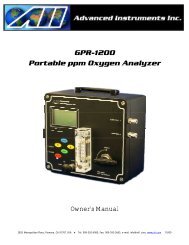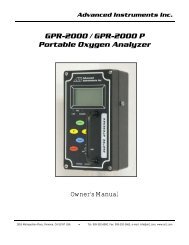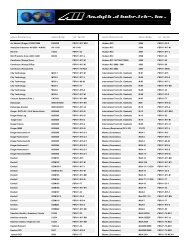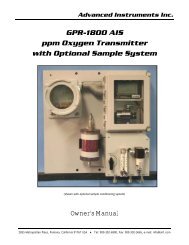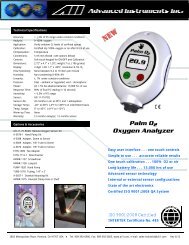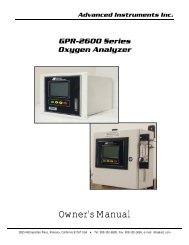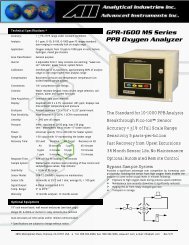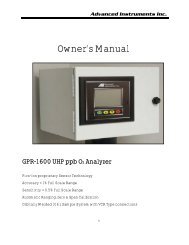GPR-18 MS ATEX Explosion Proof PPB Oxygen Analyzer.
GPR-18 MS ATEX Explosion Proof PPB Oxygen Analyzer.
GPR-18 MS ATEX Explosion Proof PPB Oxygen Analyzer.
- No tags were found...
You also want an ePaper? Increase the reach of your titles
YUMPU automatically turns print PDFs into web optimized ePapers that Google loves.
Advanced Instruments Inc.Procedure:1. Select the desired sampling range that provides maximum resolution.2. Use metal tubing to transport the sample gas to the analyzer. The main consideration is to eliminate air leaks which canaffect oxygen measurements.3. Ensure the upper and bottom sections of the sensor housing are secured tightly by the U-shaped clamp and bolt in thecenter of the bottom section of the sensor housing.4. Ensure the sample gas tube fittings are properly installed with both ferrules, finger tightened and ¾ of a turn for 1/8”tubing and 1-1/4 of a turn for ¼” tubing.5. Assure there are no restrictions in the sample gas lines – inlet or vent.6. For sample gases under positive pressure the user must provide a means of regulating the inlet pressure between 5-30psig, the analyzer is equipped with a FLOW VALVE to set the flow rate at the recommended 2 SCHF.7. For sample gases under atmospheric or slightly negative pressure an optional sampling pump is recommended to draw thesample into the analyzer. Generally, no pressure regulation or flow control device is involved.8. Caution: If the analyzer is equipped with both a FLOW valve upstream of the sensor and an integral SAMPLING PUMPdownstream of the sensor, always open the FLOW valve completely before operating the pump (avoid drawing a vacuumon the sensor).9. Assure the sample is adequately vented for optimum response and recovery – and safety.To avoid erroneous oxygen readings and damaging the sensor:1. Do not place your finger over the vent (it pressurizes the sensor) to test the flow indicator when gas is flowing to thesensor. Removing your finger (the restriction) generates a vacuum on the sensor and may damage the sensor (voiding thesensor warranty).2. If the analyzer is equipped with an optional integral sampling pump (positioned downstream of the sensor), completelyopen the flow control metering valve (positioned upstream of the sensor) to avoid drawing a vacuum on the sensor andplacing an undue burden on the pump.3. Assure there are no restrictions in the sample or vent lines4. Avoid drawing a vacuum that exceeds 14” of water column pressure – unless done gradually5. Avoid changes in flow rate and excessive flow rates which generate backpressure on the sensor.6. Avoid sudden releases of backpressure that can severely damage the sensor.7. Avoid the collection of particulates, liquids or condensation collect on the sensor that could block the diffusion of oxygeninto the sensor.StandbyThe analyzer has no special storage requirements.‣ The sensor should remain connected during storage periods – place the SAMPLE/BYPASS valve in the BYPASS position andclose the SHUT OFF completely.‣ Store the analyzer with the power OFF.‣ If storing for an extended period of time, charge before operating.27



